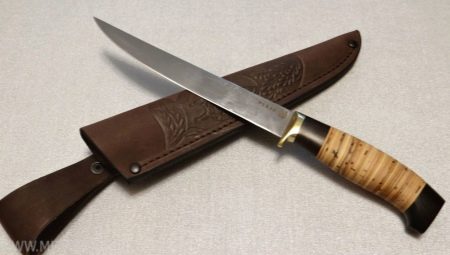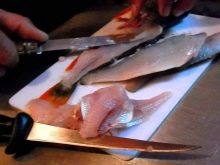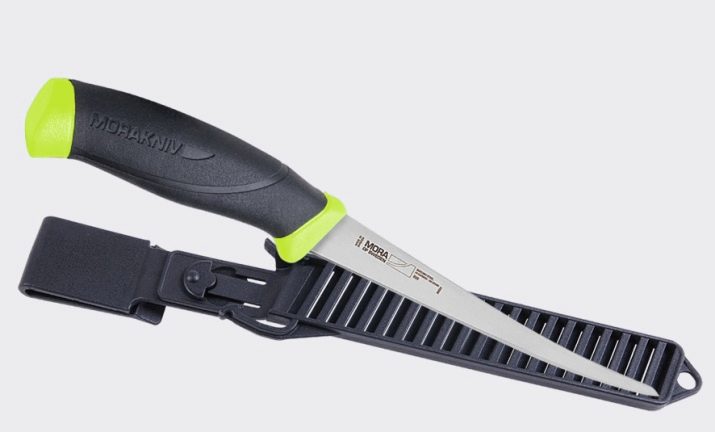Fillet knives: features and rating of the best models

The fillet knife is used for cutting not only fish, but also meat. It has a special design, thanks to which you can easily remove the pulp from the bones.



What it is?
Typically, blade lengths range from 15cm to 27cm, making this tool ideal for filleting and more. Length and flexibility allow for superior results. For example, cutting fish involves making a clean cut along the spine, because walking too close to the bones will not cut the flesh evenly.
Since the fillet knife is flexible and thin at the same time, its blade easily goes into places where ordinary kitchen tools cannot penetrate. Moving through the flesh, it quickly but neatly separates it from the bone. Then you can just as easily remove the pulp from the skin with a minimum of effort.
Although the fillet knife is most often associated with filleting fish, it is also used with success in cutting other foods. It works well for slicing roast beef, thin strips of chicken and steak. This tool is very easy to distinguish from other knives in the kitchen due to its shape.
Looking closely at the edge of the knife, it's hard not to see that the tip is very sharp. It helps to pierce meat and fish with ease. There are both rigid and flexible knives.



Hard
Designed for meat. If you plan on deboning pork, beef, or any other thick piece, you will need a stiff knife that won't bend. Due to the fact that the meat has a dense structure, it is necessary to exert more effort while separating it from the bone. The flexible knife then bends, which can lead to injury.


Flexible
These tools are intended for cutting chicken and fish when the flesh is very delicate and you need to make a clean, even cut without any torn edges.
Recently, arched blades have become more and more popular as they are the ideal choice for deboning fish. These blades allow only one pass through the carcass to remove all bones.
After sharpening, the blades are extremely sharp; each chef chooses the length for himself individually. The main thing is to feel complete control over the tool while working. Fillet knives can be curved or straight, depending on the application and filleting style.



Such a tool often has a thicker pointed end, but there are also models with a rounded end.
Models
Among the wide variety of filleting knives on offer, the following models are worth paying attention to.
Wusthof classic
The classic 7 '' fillet knife mainly used for deboning medium to large fish on an industrial scale. The blade is made of high carbon hardened stainless steel. When working, it gives high cutting accuracy and full control over the work. Another great advantage of the product is its sharpness. After the purchase, the first sharpening will not be required soon, even with intensive use. The triple riveted handle on which the blade is mounted has a durable contour, so it fits well in the hand.

Kosadaka
A folding knife that not only has an attractive design but also unique qualities. On sale there are both all-metal structures and models with a plastic handle. In the manufacture, they used strong, high-carbon steel, which can remain sharp for a long time. It is an ideal solution for hunting and fishing, when closed, the knife can be carried in your pocket, it is completely safe.

Mora
Manufactured from Sandvik 12C27 stainless steel with a medium flexible blade. The hardness of the material is 58 HRC, based on the Rockwell scale. In most models, the handle is made of polyamide. Country of origin - Sweden.

Shun DM0743
The blade is made from tough, corrosion-resistant VG-10 stainless steel mixed with 33 layers of high carbon steel. The knife has a slightly curved shape, thanks to which it is possible to quickly and easily butcher meat and fish. In the field, the product is perfect for cutting vegetables. The design of the knife is worthy of respect. The manufacturer tried to make the model as comfortable as possible, despite the 11-inch blade. The reversible Pakkawood handle is comfortable and fits well in the hand.

Zwilling J. A. Henckels Twin
The Zwilling J. A. Henckels line of specialty cutlery serves nearly one in two gourmet restaurants worldwide. This knife is made of high carbon stainless steel and has the flexibility it needs to easily cut up medium sized poultry and fish. The blade has a light, straight cutting edge.
Slim, contoured handle is ideal for small hands.

Global
A Japanese cutlery manufacturer, an established favorite, whose products are used by professional chefs. His filleting knives became a real sensation when they first hit the market.
The double beveled edge of the blade allows you to use the product with both left and right hands with equal efficiency. The blade design is the perfect fusion of unsurpassed Japanese technology and quality materials. The knife is made of stainless steel with the inclusion of molybdenum and vanadium. Each model undergoes strict quality control before it is released to the market.

Victorinox 47513
The company has become known for producing quality Swiss army knives and multitools. The blade used in the filleting knife is stamped, not forged. Such models have a slight advantage over forged ones in terms of weight.The surface of the knife is very hard, the model cannot be bent no matter how hard the meat is processed.


Rapala
A product manufactured in Sweden. Made of high quality stainless steel. Such equipment is ideal for butchering fish. The blade is 7 inches long, which is adequate for medium sized carcasses.

Mikado
A widely used knife for filleting fish on ships. The blade is additionally protected by a plastic sheath, its length is 20 centimeters, which is ideal for a large carcass of tuna. Supplied with a diamond sharpener. The handle has an ergonomic shape and is made of high quality rubber.

How to choose?
When choosing a quality knife for filleting, you should first of all pay attention to the material from which it was made. It should be thin, but strong, and the product itself should be well sharpened to easily cut through delicate flesh.
Professional tools are required that the material of manufacture has excellent corrosion resistance and the required rigidity. Stainless steel is the most popular metal for these knives, but not every type offers superior quality. To use your money wisely, you should always consider a well-known, established brand.
Ergonomics plays an important role when choosing kitchen utensils. The handle of the knife should have the correct, comfortable shape so that it fits well in the palm of your hand and does not slip out, even if it is wet.


It is very important to choose a knife with a handle that is at the right angle to the blade. In this case, it will provide minimal impact on the finger during filleting of the fish. Today, cheap and durable non-slip materials such as plastic and rubber have replaced traditional wooden handles.

The size of the blade plays a key role in determining the quality of the rounding. Large blades are needed to cut large fish. Such fish are most often prepared in restaurants and fish markets. Small to medium sized accessories find their place in the kitchen of ordinary housewives, they are usually used for deboning meat and small fish. Good flexibility is extremely important for small knives used at home as it allows the blade to be easily guided along the spine.
When choosing a product it is better to overpay a little than to throw the knife in the trash after a few months. It is always worth giving preference to quality, so it will not be superfluous to look through the rating of the best products made of damask or damask steel, even handmade. There is nothing wrong with spending a little time researching the assortment of famous brands. Such a product always looks worthy, and only minimal experience is needed to make a choice in the right direction, since the technical characteristics are always fully described on the official websites of the manufacturers.
In the next video, you will see an overview of several fillet knives.








